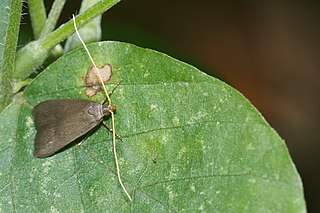
The Lecithocerinae are a subfamily of small moths in the family Lecithoceridae. They are found worldwide, but most species occur in South Asia. The subfamily is characterized by the male genitalia with a bridge-like structure connecting the tegumen and the valva, and the uncus almost always is vestigal with two lobes at the dorsal base, only exceptionally united into a broad plate, but never as a thorn or spine.
Frisilia is a genus of moths in the family Lecithoceridae. The genus was erected by Francis Walker in 1864.
Amaloxestis callitricha is a moth in the family Lecithoceridae. It was described by Edward Meyrick in 1910. It is found in Assam, India.
Frisilia compsostoma is a moth in the family Lecithoceridae. It was described by Edward Meyrick in 1921. It is found in the Democratic Republic of the Congo's former Katanga Province and in Zimbabwe.
Frisilia melanardis is a moth in the family Lecithoceridae. It was described by Edward Meyrick in 1910. It is found on Borneo.
Frisilia procentra is a moth in the family Lecithoceridae. It was described by Edward Meyrick in 1916. It is found in southern India.
Frisilia strepsiptila is a moth in the family Lecithoceridae. It was described by Edward Meyrick in 1910. It is found in southern India.
Frisilia sulcata is a moth in the family Lecithoceridae. It was described by Edward Meyrick in 1910. It is found in Nepal and Assam, India.
Frisilia verticosa is a moth in the family Lecithoceridae. It was described by Edward Meyrick in 1914. It is found in southern India.
Frisilia dipsia is a moth in the family Lecithoceridae. It was described by Edward Meyrick in 1910. It is found in Sri Lanka.
Frisilia heliapta is a moth in the family Lecithoceridae. It was described by Edward Meyrick in 1887. It is found in Sri Lanka.
Frisilia notifica is a moth in the family Lecithoceridae. It was described by Edward Meyrick in 1910. It is found in Sri Lanka.
Frisilia rostrata is a moth in the family Lecithoceridae. It was described by Edward Meyrick in 1906. It is found in Sri Lanka.
Frisilia sejuncta is a moth in the family Lecithoceridae. It was described by Edward Meyrick in 1929. It is found in southern India and Sri Lanka.
Frisilia triturata is a moth in the family Lecithoceridae. It was described by Edward Meyrick in 1914. It is found in the Democratic Republic of the Congo and Malawi.
Frisilia homochlora is a moth in the family Lecithoceridae. It was described by Edward Meyrick in 1910. It is found in southern India and Jiangxi, China.
Timyra praeceptrix is a moth in the family Lecithoceridae. It was described by Edward Meyrick in 1910. It is found in Sri Lanka.
Lecithocera crebrata is a moth in the family Lecithoceridae. It was described by Edward Meyrick in 1910. It is found in southern India.
Sarisophora tamiodes is a moth in the family Lecithoceridae. It was described by Edward Meyrick in 1910. It is found on New Guinea.
Deltoplastis straminicornis is a moth in the family Lecithoceridae. It was described by Edward Meyrick in 1910. It is found in Sri Lanka.
